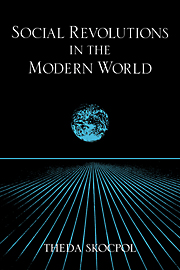Book contents
- Frontmatter
- Contents
- Acknowledgments
- INTRODUCTION
- I DOING MACROSCOPIC SOCIAL SCIENCE
- II MAKING SENSE OF THE GREAT REVOLUTIONS
- III A DIALOGUE ABOUT CULTURE AND IDEOLOGY IN REVOLUTIONS
- IV FROM CLASSICAL TO CONTEMPORARY SOCIAL REVOLUTIONS
- 9 What makes peasants revolutionary?
- 10 Rentier state and Shi'a Islam in the Iranian Revolution
- 11 Explaining revolutions in the contemporary Third World
- 12 Social revolutions and mass military mobilization
- CONCLUSION
- Index
9 - What makes peasants revolutionary?
Published online by Cambridge University Press: 05 June 2012
- Frontmatter
- Contents
- Acknowledgments
- INTRODUCTION
- I DOING MACROSCOPIC SOCIAL SCIENCE
- II MAKING SENSE OF THE GREAT REVOLUTIONS
- III A DIALOGUE ABOUT CULTURE AND IDEOLOGY IN REVOLUTIONS
- IV FROM CLASSICAL TO CONTEMPORARY SOCIAL REVOLUTIONS
- 9 What makes peasants revolutionary?
- 10 Rentier state and Shi'a Islam in the Iranian Revolution
- 11 Explaining revolutions in the contemporary Third World
- 12 Social revolutions and mass military mobilization
- CONCLUSION
- Index
Summary
The centrality of peasants in modern revolutions was underscored for the first time in contemporary North American scholarship by Barrington Moore, Jr., in Social Origins of Dictatorship and Democracy: Lord and Peasant in the Making of the Modern World. Eloquently, the opening sentences of Moore's chapter on “The Peasants and Revolution” declared that the “process of modernization begins with peasant revolutions that fail. It culminates during the twentieth century with peasant revolutions that succeed” (Moore, 1966: 453). Social Origins in fact proved uncannily prescient and timely in its emphasis on the revolutionary potential of the peasantry. When Moore's great opus was in preparation during the 1950s and early 1960s, neither Marxism nor orthodox social science paid much heed to the roles of agrarian classes in “the making of the modern world.” The peasantry, especially, was spurned as the repository of conservatism and tradition, of all that needed to be overcome by a revolutionary bourgeoisie or proletariat, or by a modernizing elite. But once the United States became tragically engaged from the mid-1960s in a military effort to stymie the Vietnamese Revolution, U.S. scholars quite understandably became fascinated with the revolutionary potential of the peasantry – especially in the Third World. The questions addressed by Moore's chapter on peasants in Social Origins – “what kinds of social structures and historical situations produce peasant revolutions and which ones inhibit or prevent them” (Moore, 1966: 453) – were immediately relevant for an entire nascent genre of research and theorizing on peasants and revolution.
- Type
- Chapter
- Information
- Social Revolutions in the Modern World , pp. 213 - 239Publisher: Cambridge University PressPrint publication year: 1994
- 1
- Cited by



